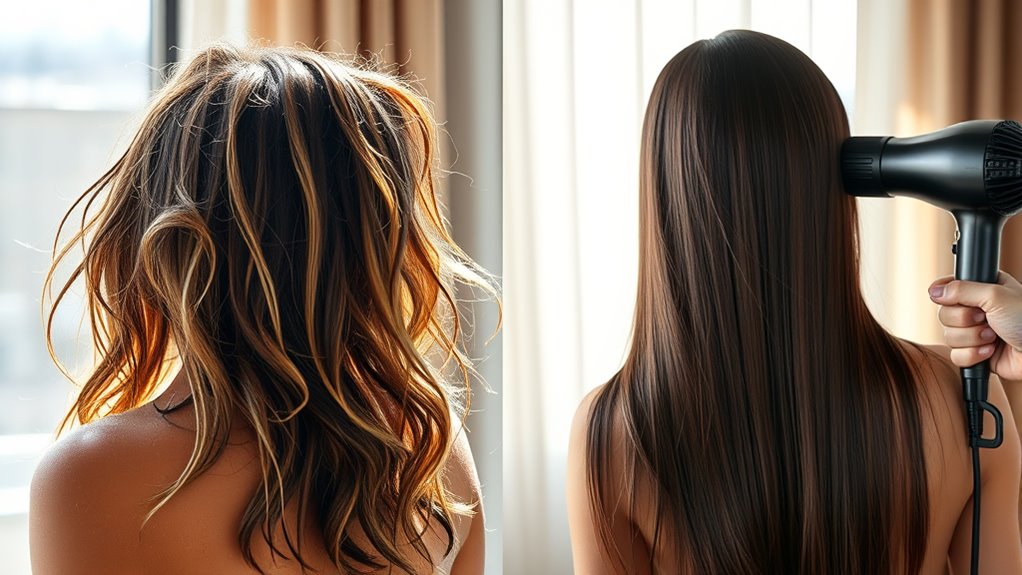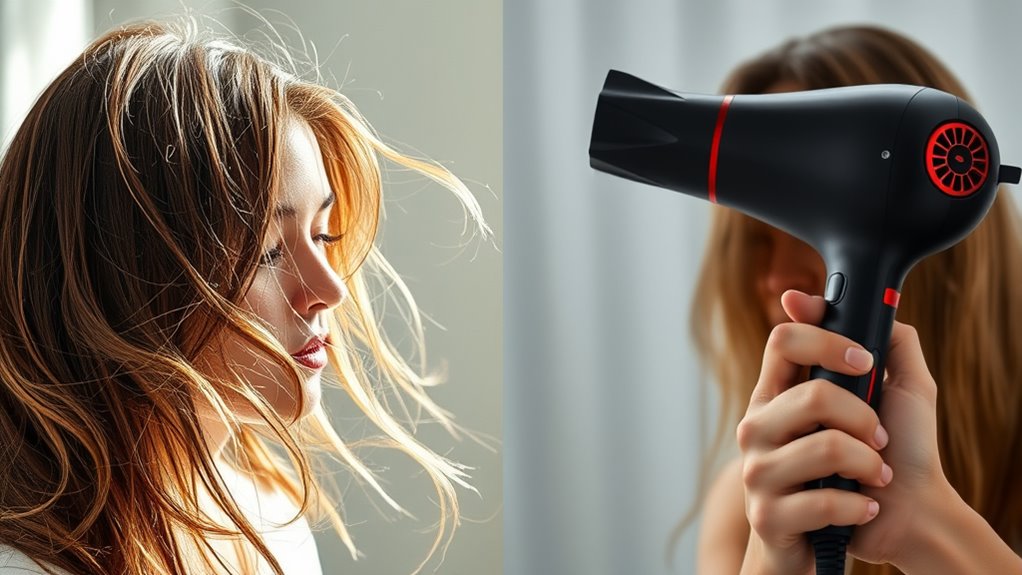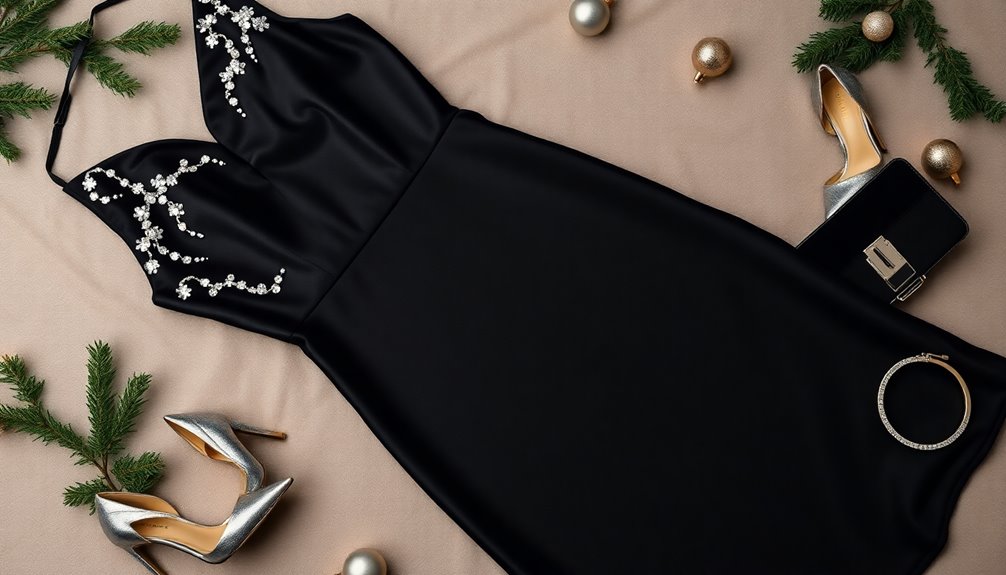Choosing between air-drying and blow-drying depends on your hair type and style goals. Air-drying minimizes heat damage, promotes natural shine, and gives a relaxed look, but takes longer and offers less control. Blow-drying is faster, provides more styling options, but can cause heat damage if not done carefully. Using heat protectants and adjusting settings can help. Keep exploring to discover how to select the best method for your hair and lifestyle.
Key Takeaways
- Air-drying minimizes heat damage and promotes natural shine, but takes longer and offers less styling control.
- Blow-drying provides quick, versatile styling options but can cause heat damage without proper precautions.
- Combining air-drying (70%) with a finishing blow-dry offers a healthy balance of style and hair preservation.
- Use heat protectant sprays and moderate temperatures to reduce damage when blow-drying.
- Choose the drying method based on hair type, styling needs, and time availability for optimal results.

When deciding how to dry your hair, you often choose between air-drying and blow-drying, each offering distinct benefits and drawbacks. Air-drying is gentle on your hair, notably reducing the risk of heat damage, which can weaken strands over time and lead to breakage. If you’re aiming to maintain healthy, shiny hair, this method is a solid choice. Plus, air-drying allows your natural texture to shine through, giving you a relaxed, effortless look. However, it can take longer, especially if your hair is thick or long, and it might not lend itself well to quick styling or achieving certain looks.
Air-drying minimizes heat damage, promotes natural shine, but takes longer for thick or long hair.
Blow-drying, on the other hand, offers greater styling versatility. With a good blow-dryer and the right tools, you can create sleek, voluminous, or textured styles in a fraction of the time. This method allows you to mold your hair into various shapes, whether that’s a smooth finish or big, bouncy curls. But, the trade-off comes with potential heat damage. Frequent blow-drying without proper heat protection can weaken your hair, cause dryness, and lead to split ends. That’s why it’s essential to use heat protectant sprays and to keep the dryer at a moderate temperature, especially if you blow-dry often.
If you’re concerned about heat damage, air-drying is the safer option, but it may limit your styling options. To get the most out of blow-drying without harming your hair, consider applying heat protectant products before drying. Use the lowest effective heat setting and keep the dryer moving to avoid concentrating heat on one spot. Combining blow-drying with air-drying can also work well—air-dry until your hair is about 70% dry, then finish with a blow-dryer for added volume or style. This reduces overall heat exposure while still giving you style versatility. Additionally, understanding hair technology can help you choose the right tools and techniques to minimize damage and maximize results.
Ultimately, your choice depends on your hair type, lifestyle, and styling goals. If you prefer a quick, polished look and like experimenting with different styles, blow-drying might be your best bet—just be mindful of heat damage. If you prioritize hair health and a natural appearance, air-drying is better, especially if you’re willing to wait a little longer. By understanding the pros and cons of each method, you can make informed decisions that balance style, convenience, and hair health.
Frequently Asked Questions
How Long Does Air-Drying Typically Take Compared to Blow-Drying?
Air-drying usually takes considerably longer than blow-drying, often between 30 minutes to an hour depending on hair thickness and length. Blow-drying can cut your hair drying duration to about 10-20 minutes, making it a quicker option. The drying time comparison shows that air-drying is more time-consuming, but it’s gentler on your hair. If you’re in a hurry, blow-drying offers a faster solution, while air-drying suits those prioritizing hair health.
Can Air-Drying Cause More Damage Than Blow-Drying?
Air-drying generally causes less heat damage since it doesn’t expose your hair to high temperatures. However, it can lead to moisture retention if your hair stays damp for too long, which might weaken strands and cause frizz. Blow-drying, when done carefully with heat protection, minimizes moisture retention and speeds up drying, reducing the risk of damage. So, choosing the right method depends on your hair type and how you dry it.
Which Method Is Better for Curly or Textured Hair?
Imagine your curls as a delicate garden needing gentle care. Air-drying, like tender sunlight, preserves moisture and minimizes heat damage, making it ideal for textured hair. Blow-drying, like a gust of wind, risks stripping moisture and causing damage. For best results, embrace air-drying or use a diffuser on low heat. This keeps your curls moisturized and resilient, giving your hair a healthier, bouncier look.
Are There Specific Hair Types That Benefit More From Air-Drying?
You’ll find that high-porosity hair benefits more from air-drying, as it absorbs moisture quickly and needs gentle drying to prevent damage. If you have scalp sensitivity, air-drying reduces irritation compared to blow-drying, which can be harsh with heat. Low-porosity hair also responds well, as air-drying allows moisture to penetrate gradually. Overall, air-drying suits hair types needing gentler, less invasive drying methods.
How Do Environmental Factors Influence Drying Time and Hair Health?
Environmental factors like humidity effects and temperature influence your hair’s drying time and health. High humidity slows down air-drying, making it take longer and increasing frizz, while low humidity speeds up the process. Warm temperatures can help your hair dry faster, but excessive heat can damage strands. To protect your hair, adjust your drying method based on these conditions, opting for air-drying in humid weather or using gentle blow-drying in cooler, dry environments.
Conclusion
Choosing between air-drying and blow-drying comes down to care, convenience, and style. You can embrace the natural, gentle process of air-drying or enjoy the quick, versatile results of blow-drying. You can prioritize health, save time, or experiment with looks. You can minimize damage, maximize volume, or maintain moisture. Ultimately, your hair’s health depends on your choices. Make informed decisions, embrace your routine, and adapt your drying method to suit your hair’s needs and your lifestyle.









